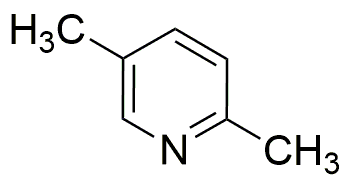2,5-Lutidine is widely utilized in research focused on:
- Synthesis of Pharmaceuticals: This compound serves as a crucial building block in the synthesis of various pharmaceuticals, enhancing the efficiency of drug development processes.
- Organic Synthesis: It acts as a solvent and reagent in organic reactions, making it valuable for chemists looking to create complex molecules with precision.
- Agrochemical Production: 2,5-Lutidine is used in the formulation of agrochemicals, contributing to the development of effective pesticides and herbicides that improve crop yields.
- Electrochemical Applications: Its properties make it suitable for use in electrochemical cells, where it can enhance the performance of batteries and fuel cells.
- Research in Material Science: This compound is explored for its potential in creating advanced materials, particularly in the development of polymers and coatings with improved durability.
General Information
Properties
Safety and Regulations
Applications
2,5-Lutidine is widely utilized in research focused on:
- Synthesis of Pharmaceuticals: This compound serves as a crucial building block in the synthesis of various pharmaceuticals, enhancing the efficiency of drug development processes.
- Organic Synthesis: It acts as a solvent and reagent in organic reactions, making it valuable for chemists looking to create complex molecules with precision.
- Agrochemical Production: 2,5-Lutidine is used in the formulation of agrochemicals, contributing to the development of effective pesticides and herbicides that improve crop yields.
- Electrochemical Applications: Its properties make it suitable for use in electrochemical cells, where it can enhance the performance of batteries and fuel cells.
- Research in Material Science: This compound is explored for its potential in creating advanced materials, particularly in the development of polymers and coatings with improved durability.
Documents
Safety Data Sheets (SDS)
The SDS provides comprehensive safety information on handling, storage, and disposal of the product.
Product Specification (PS)
The PS provides a comprehensive breakdown of the product’s properties, including chemical composition, physical state, purity, and storage requirements. It also details acceptable quality ranges and the product's intended applications.
Certificates of Analysis (COA)
Search for Certificates of Analysis (COA) by entering the products Lot Number. Lot and Batch Numbers can be found on a product’s label following the words ‘Lot’ or ‘Batch’.
Numéro de catalogue
Numéro de lot/série
Certificates Of Origin (COO)
This COO confirms the country where the product was manufactured, and also details the materials and components used in it and whether it is derived from natural, synthetic, or other specific sources. This certificate may be required for customs, trade, and regulatory compliance.
Numéro de catalogue
Numéro de lot/série
Safety Data Sheets (SDS)
The SDS provides comprehensive safety information on handling, storage, and disposal of the product.
DownloadProduct Specification (PS)
The PS provides a comprehensive breakdown of the product’s properties, including chemical composition, physical state, purity, and storage requirements. It also details acceptable quality ranges and the product's intended applications.
DownloadCertificates of Analysis (COA)
Search for Certificates of Analysis (COA) by entering the products Lot Number. Lot and Batch Numbers can be found on a product’s label following the words ‘Lot’ or ‘Batch’.
Numéro de catalogue
Numéro de lot/série
Certificates Of Origin (COO)
This COO confirms the country where the product was manufactured, and also details the materials and components used in it and whether it is derived from natural, synthetic, or other specific sources. This certificate may be required for customs, trade, and regulatory compliance.


